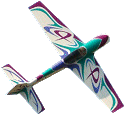1. Engine Set-up - Where to start, before you start!
Assuming you have a computer radio, adjust the Carburetor.
throw using the 'T.ADJ' setting so that the Carburetor. barrel
is fully opened in the Carburetor. housing when the throttle
stick on the transmitter is pushed fully forward in the full
throttle position.
Pull the stick fully back to the idle position. Open the main
needle approx. 2 turns, place a modeling pin into the body
of the carb and adjust the throttle barrel again by using
the 'T.ADJ' setting in your transmitter until it just makes
contact with the pin, this will establish a rough barrel set-up
gap for idle running.
Fine adjustment can be made up at the flying field with the
engine running and tuned. Remove the pin and store the settings
in your transmitter. Now fit a length (6-8 ') of fuel tube
to fuel intake nipple on the Carburetor. gently blow down
the tube, if you can just about hear air escaping, it´s
set about right. If it is easy to blow air through, then the
slow running needle needs to be screwed in (clockwise), if
you go blue and nearly pass out trying to blow, unscrew the
slow running needle (anticlockwise) until you can just hear
air escaping. Use only 1/8 turns at a time
for this adjustment!
2. Main needle (top end) adjustment
Fuel and fire her up! Let the engine warm up and clear it's
throat for about 30 sec´s at full throttle. Now you're
going to set the main needle valve, this is done with the
engine at full throttle.
The sound you are looking for is a clear, crisp and constant
sound. If the engine is '4 stroking', then it is running too
rich, lean it out by screwing the main needle in (clockwise)
until the engine rpm peeks, then richen it by 2 clicks, hold
the nose of the aircraft up, (still on full throttle) if the
engine starts to die, then you need to richen it by unscrewing
(anticlockwise) by 1 to 2 clicks and check it again with the
nose up. You should get to the point where the engine note
should not change from the horizontal to vertical position
on full throttle. You have just tuned the 'top end'.
3. Slow running (bottom end) adjustment
Firstly I suggest that you make all slow running (bottom
end) adjustments with the engine stopped, as the adjustment
screw is generally situated very close to the turning 'circular
saw' like propeller. Stop the engine, make the adjustment,
restart the engine, perform tests, stop the engine, make any
necessary adjustment etc. etc. etc. From full throttle chop
the engine back to idle, if the engine very slowly drops back
to idle and the idle drops still further.
Make all adjustments with the
glow plug lead off
Leave the engine at idle for 20 seconds, then increase the
throttle to full. If it coughs, and splutters and takes it´s
time to reach full rpm then the bottom end or slow running
needle is set too rich. Screw it in (clockwise) by no more
than a 1/8 of a turn at a time Clear the engine by holding
it at full throttle for 10 seconds, then drop it to idle for
20 seconds and repeat the test.
If however the engine just dies when you open the throttle
from being at tick over for 20 seconds then the bottom end
or slow running adjustment is set too lean, unscrew it (anticlockwise)
by no more than a 1/8 of a turn at a time. Clear the engine
by holding it at full throttle for 10 seconds, then drop it
to idle for 20 seconds and repeat the test.
As you do these slow running adjustments make sure you continue
to check the main needle setting (re-adjust if necessary)
on full throttle as described in '2. Main needle - top end
adjustment' as this will alter slightly during the set up
procedure of the bottom end.
Another way of testing that you have the bottom end adjusted
correctly is to pinch the fuel line just before the carburetor.
If after a couple of seconds the engine speeds up before dying
the bottom end is too rich. If the engine dies almost immediately
when you pinch the tube then the mixture is too lean. A correctly
set up bottom end is when you pinch the tube and there is
no rise or fall in RPM for 3-4 seconds. After 3-4 seconds
the engine's RPM will slowly drop until it eventually dies.
4. Handy Tip
If you find the engine is fine with the glow lead attached,
but slows dramatically or even stops as soon as you remove
it, the glow plug is 'cream crakered', time for a new one.
The instructions that come with the engine should recommend
a suitable plug to use, if not for starters try a good old
'bullet proof' Enya No3 for engines up to 0.90. and an OS
'F Type' for all 4 stroke engines.
5. Too Hot!
If the engine has got too hot, allow it to cool down as this
will affect the tuning of the engine!! You will know when
you´re about there, because a well set up model engine
will have the throttle response very similar to a racing car!!
Instant pickup from 'longish' periods of idle and a smooth
return back to idle. GOOD LUCK. It sound´s a pain to
do, but it's actually fairly easy, and makes flying a lot
more fun with a powerful and reliable engine. |

